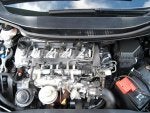Hi everybody,
I’ve recently bought a Honda Civic 2006 2.2 cdti sport. After a while it gave me an “Check System” error with the little engine icon with exclamation mark. I hope someone could help me out with this problem.
I did take an OBD2 readout on it, and it gave me the following fault code:
P2006: Intake Manifold Runner Control Stuck Closed Bank 1
The car has some history. It’s been used for 3 years and in 2009 (150.000 kilometers driven) it had a massive injector malfunction. The car has been standing still till now. The recently replaced the 4 injectors, oil, coolant, EGR valve controller, cylinder head, head and gaskets. It drives fine, but since I never driven a Civic before, I don’t know if the motor runs in optimal condition.
After some internet research myself I’ve found some interesting information. But since I’m not a mechanic myself (But I’m pretty handy) I really could use some personal advice.
What I’ve found out is that number one suspect is the “Swirl valve”. It suppose to let extra air into the cylinder to swirl the air-diesel mixture around for a better explosion (right?). My guess is that if this is stuck the engine still runs smoothly but less economical. My second guess is that since the car has not been driven for the past 4 years, the valve is a bit stuck. Maybe a tiny bit corrosion, or solidified oil…
My question: Is it possible for me to see if the “Swirl valve” or control rod works without taken of the complete manifold? And if it’s stuck, what can I do to un-stuck it. Is it possible to detach a hose to see the actual “Swirl valve” and may I spray it with some WD40? If it’s possible, a picture from the engine with an arrow where to look would really help me.
I’ve recently bought a Honda Civic 2006 2.2 cdti sport. After a while it gave me an “Check System” error with the little engine icon with exclamation mark. I hope someone could help me out with this problem.
I did take an OBD2 readout on it, and it gave me the following fault code:
P2006: Intake Manifold Runner Control Stuck Closed Bank 1
The car has some history. It’s been used for 3 years and in 2009 (150.000 kilometers driven) it had a massive injector malfunction. The car has been standing still till now. The recently replaced the 4 injectors, oil, coolant, EGR valve controller, cylinder head, head and gaskets. It drives fine, but since I never driven a Civic before, I don’t know if the motor runs in optimal condition.
After some internet research myself I’ve found some interesting information. But since I’m not a mechanic myself (But I’m pretty handy) I really could use some personal advice.
What I’ve found out is that number one suspect is the “Swirl valve”. It suppose to let extra air into the cylinder to swirl the air-diesel mixture around for a better explosion (right?). My guess is that if this is stuck the engine still runs smoothly but less economical. My second guess is that since the car has not been driven for the past 4 years, the valve is a bit stuck. Maybe a tiny bit corrosion, or solidified oil…
My question: Is it possible for me to see if the “Swirl valve” or control rod works without taken of the complete manifold? And if it’s stuck, what can I do to un-stuck it. Is it possible to detach a hose to see the actual “Swirl valve” and may I spray it with some WD40? If it’s possible, a picture from the engine with an arrow where to look would really help me.










